|
 Physarum cinereum Physarum cinereum
SynonymsBadhamia calvescens
Didymium cinereum
Lycoperdon cinereum
BiostatusPresent in region - Indigenous. Non endemic
Images (click to enlarge)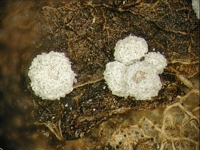
Caption: fruitbody
Owner: J.A. Cooper | 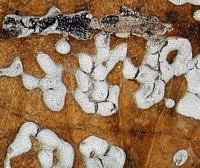
Owner: J.A. Cooper | 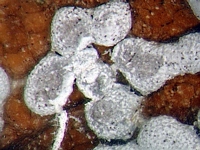
Owner: J.A. Cooper | 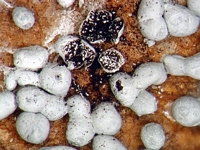
Owner: J.A. Cooper | 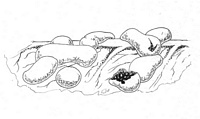
Caption: A fruiting of Physarum cinereum on a dead leaf. The individual sporangia are about 0.6 mm in diameter.[
Owner: S.L. Stephenson | 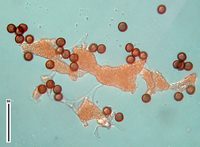
Caption: capillitium and spores in KOH
Owner: J.A. Cooper |
Article: Macbride, T.H. (1926). A bit of Polynesian mycology. Mycologia 18(3): 125-131.
Description: Fructification closely gregarious; sporangia dark grey, ovate or cylindric, sessile, or
narrowed below, but not strictly stipitate ; about 1 mm high, with apical dehiscence; the
capillitium dense, the tubules very short, the nodes large, irregular, white, physaroid, more
or less aggregate at the center, otherwise no columella; spores dark violaceous, coarsely
spinulose, thick-walled save for a limited area apparently thinner, but bearing a few
scattered spinules, 12-14 µm.
Notes: Resemblance is with B. papaveracea (Berk.) Rost.; the spores are adherent in fours,
apparently; but there are no stems and the sporangia are cylindric or irregularly prolate.
Article: Stephenson, S.L. (2003). Myxomycetes of New Zealand. Fungi of New Zealand. Ngā Harore o Aotearoa 3: xiv + 238 p. Hong Kong: Fungal Diversity Press.
Description: Fruiting body a sessile sporangium (or often forming a short plasmodiocarp), closely gregarious to crowded or heaped, subglobose to pulvinate, 0.3–0.5 mm in diameter. Hypothallus membranous, colourless to white, often inconspicuous. Peridium consisting of a single layer, membranous, more or less densely covered or impregnated with lime, white to cinereous (or iridescent to dark brown when limeless). Columella absent. Capillitium consisting of numerous, variously shaped, mostly angular or branching white lime nodes (these occasionally massed in the centre) connected by hyaline filaments. Spores purplish brown in mass, light violaceous by transmitted light, asperulate to minutely warted, 9–11 µm in diameter. Plasmodium watery white or colourless, reported to become at times bright yellow before fruiting.
Habitat: Dead leaves; also fruiting on living plants.
Distribution: Reported as cosmopolitan (Martin & Alexopoulos 1969) but probably most common in temperate regions of the world. First reported (as Didymium cinereum) from New Zealand by Berkeley (1855), based on a specimen collected by W. Colenso in Northland. Also known from Auckland, Coromandel, Waikato, Bay of Plenty, Taranaki, Taupo, Wanganui, Wellingon, Hawkes Bay, Wairarapa, Nelson, Marlborough, North Canterbury, Mid Canterbury, South Canterbury (Lister & Lister 1905), Dunedin (Rawson 1937), Southland (Rawson 1937), and Campbell Island.
Notes: Several other species of Physarum produce sessile sporangia and are found in similar situations, but none of these is known to produces the extensive fruitings sometimes characteristic of P. cinereum. One example of an exceptionally large fruiting in a grassy area in Auckland had a diameter of approximately 8 meters (Peter Buchanan, personal communication).
|